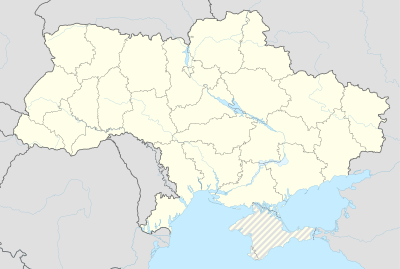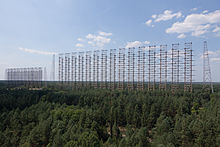Woodpecker (short wave signal)
Woodpecker ( English " Specht ") is the name of a Soviet shortwave signal that was heard on radio frequencies between July 1976 and December 1989 worldwide. The random frequency changes disrupted public broadcasting and radio amateurs, which led to thousands of complaints worldwide. The signal sounded like a sharp knock, which was usually repeated at a frequency of 10 Hz . The power of the signal was estimated at 10 MW EIRP . The transmission took place on changing frequencies in the shortwave range between 7 and 19 MHz. The resemblance to the knocking of a woodpecker led to its name.
It was assumed quite early on that the signal belonged to a Soviet over-the-horizon radar . This theory was confirmed after the fall of the Soviet Union . The signal was generated by facilities called Duga (German: Bogen), which were part of the Soviet missile defense system . With these radar devices, a possible launch of rockets in Europe and America should be detected at an early stage. A detection range of up to 15,000 km can be derived from the obviously high transmission power of the Duga systems and the pulse frequency of 10 Hz. At NATO , the facilities were called Steel Yard . The most famous of these plants is located in Ukraine in the immediate vicinity of the former Chernobyl nuclear power plant . Only when this site had to be abandoned due to the reactor explosion there in 1986 did details and photos of the facility become public.
Locations
There were a total of three plants at locations within the former Soviet Union. For technical reasons, the transmitter and receiver were each set up a few kilometers apart:
- The first test facility 5H77, later called Duga (without numbering), near Mykolaiv (transmitter 46 ° 48 ′ 26 ″ N , 32 ° 13 ′ 12 ″ E , receiver 47 ° 2 ′ 28 ″ N , 32 ° 11 ′ 57 ″ E ) was located in southern Ukraine; The transmitter and receiver are completely dismantled.
- At the Duga-1 facility (often incorrectly referred to as Duga-3 in a different way of counting) near Chernobyl there are receivers ( 51 ° 38 ′ 16 ″ N , 30 ° 42 ′ 10 ″ E ) and transmitters ( 51 ° 18 ′ 19 ″ N , 30 ° 3 ′ 57 ″ E ) about 50 kilometers apart. The transmitter system consisted of around 50 large antennas with a height of up to 150 meters each. The range was 9000 kilometers. The reception system consists of two systems of different sizes built in line. For the operation of the system and the evaluation of the data, numerous specialists were required, who lived in a settlement of around 2000 people in the immediate vicinity of the recipient. After the Chernobyl disaster , this location had to be abandoned. The transmitter at Lyubetsch was partially dismantled and installed in Komsomolsk am Amur , the receiver system is located in the Chernobyl exclusion zone and still exists today.
- The Duga-2 facility was located at Komsomolsk-on-Amur (transmitter 50 ° 53 '34 " N , 136 ° 50' 13" E , receiver 50 ° 23 '8 " N , 137 ° 19' 42" E ) near the Pacific built. New York is 9400 kilometers away from there. This plant was partially dismantled in 1989.
Theories about the purpose of the signal
During the Cold War, the facility was subject to strict military secrecy. It quickly became clear that the signal belonged to a radar system, but many theories were formed about its purpose. These ranged from a system for influencing the weather to monitoring the minds of the Soviet population. One theory to be taken seriously was that the signal alone was intended to interfere with western radio. However, this was refuted after it became known that e.g. B. Radio Moscow was also affected by interference.
Reappearance of the signal
Since 2013, many radio amateurs worldwide have reported a reappearance of the Woodpecker signal. According to Globalsecurity.org, this is the new Russian OTH Radar System Kontayner with an estimated range of 3000 km. The Russian identifier according to the GRAU index is 29B6. The transmitter is located in the Nizhny Novgorod region and the receiving station in Kowylkino .
future
According to Russian Defense Minister Sergei Shoigu , the successor system has been fully functional since the end of 2015. Another station should be built in the Far East of Russia by 2018 and a total of six stations should be operational by 2020.
Web links
- The Russian Woodpecker , Miami Herald , July 1982.
- Steel Yard OTH , globalsecurity.org
Individual evidence
- ^ "Chernobyl-2" part 1. In: lplaces.com. October 17, 2007, accessed June 14, 2018 .
- ↑ Duga radar. In: Totally Lost. Retrieved January 4, 2019 (American English).
- ↑ Duga radar. In: Totally Lost. Retrieved January 4, 2019 (American English).
- ↑ a b Nick Reimer: The Untold Story of the End of the Cold War. In: Zeit Online. Zeit Online GmbH, April 25, 2016, accessed on June 14, 2018 .
- ^ Duga OTH Radars. In: Numbers Stations Research. February 8, 2016, Retrieved January 4, 2019 (American English).
- ↑ 29B6 'Kontayner' OTH Radar - Signal Identification Wiki. In: www.sigidwiki.com. Retrieved June 20, 2016 .
- ^ A b John Pike: 29B6 Konteyner Over The Horizon Radar (OTHR). In: www.globalsecurity.org. Retrieved June 20, 2016 .



